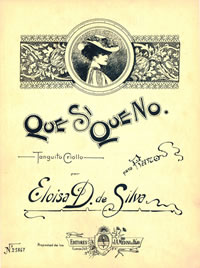By
Eloísa de Silva, the first woman composer of tangos

ndalusian musician, Eloísa D'Herbil de Silva, was born in Cadiz, Spain. She was known as the Chopin with skirts. She studied with Liszt who was responsible for that sobriquet. In our country she spent seventy-five of her one hundred and one years of life.
Was she the first woman that composed tangos? Surely she was. At age twenty-six she arrived and that same year she married the Uruguayan Federico de Silva who was twenty years her senior and was connected with the most notable families of his country.
Here she was acquainted with Domingo Sarmiento, Juan Bautista Alberdi, Bartolomé Mitre, Carlos Guido y Spano and other names of politics and culture.
She stood out for her precocity. At age thirteen in Spain she played her first concert at the Teatro Real of Madrid. In Europe she was acclaimed and was awarded by Queen Isabel II of Spain and Queen Victoria of England. Thereafter she was forgotten.
Her father was a baron, her maternal grandfather was a duke in the city of Foggia, Italy. As her father was the owner of large estates in Cuba, she settled there for some years. The girl never ceased remembering those childhood days, to such an extent that when she wrote letters she used to say that she was Cuban. As she sold meat to Brazil from Cuba to feed slaves she periodically came to Argentina. That is the reason of the start of her relationship with this country. But still her years of young concert player touring the main European countries displaying her artistry were to come.
While in Cuba she studied with the great American pianist Louis Moreau Gottschalk. She accompanied him when he appeared at a theater of La Habana in 1861 and at the old Teatro Colón of Buenos Aires in 1868.
She met the one who later would be her husband in Rio de Janeiro. There began the courtship that culminated in marriage in Buenos Aires in 1869 at the De La Piedad church. Her husband, owner of an important auction house, greatly contributed to introduce Eloísa into the social circles of Buenos Aires. The millionaire Silva was not alien to music because in 1854 he was president of the Philharmonic Society, later presided by Valentín Alsina. The married couple lived first on 50 Tacuarí Street and later, on Arenales Street. In both houses the musical reunions were customary.
She began to compose pieces for singer, reciter and piano, like “Rayo de luna” with words by Carlos Guido Spano, “Los barqueros” on rhymes by Becker and other numbers more. These pieces had a similarity with “Llora, llora urutaú” that Francisco Hargreaves composed on a poem by Guido Spano.
 On August 10, 1872 in a concert to raise funds for the old Teatro Colón, Eloísa D’Herbil de Silva premiered a habanera, then a boom, named “Vente a Buenos Aires”. After that year she composed some tangos: “El Maco” (same name that the one written by Miguel Tornquist), “El queco” (in 1874 the air of “El queco” was harmonized by Julián Aguirre and named “Aire criollo Nº 3), “¡Che, no calotiés!”, “Calote”, “La multa”, “Y a mi qué”, “Por la calle de Arenales”, “Yo soy la rubia” (that was released as a response to “La morocha” and with lyrics also written by her), “Evangélica” (released as Cuban tango), “El mozo rubio”, “Que sí que no” and others that belong to private collections and which for years were regarded as made by anonymous composers.
On August 10, 1872 in a concert to raise funds for the old Teatro Colón, Eloísa D’Herbil de Silva premiered a habanera, then a boom, named “Vente a Buenos Aires”. After that year she composed some tangos: “El Maco” (same name that the one written by Miguel Tornquist), “El queco” (in 1874 the air of “El queco” was harmonized by Julián Aguirre and named “Aire criollo Nº 3), “¡Che, no calotiés!”, “Calote”, “La multa”, “Y a mi qué”, “Por la calle de Arenales”, “Yo soy la rubia” (that was released as a response to “La morocha” and with lyrics also written by her), “Evangélica” (released as Cuban tango), “El mozo rubio”, “Que sí que no” and others that belong to private collections and which for years were regarded as made by anonymous composers.
Her oeuvre consists of over one hundred pieces. Among them we mention “Marcha fúnebre a Sarmiento”, “Himno del Congreso Eucarístico” (1934), “Plegaria a la Virgen de Luján”.
She returned to Europe on a pleasure tour. Later the passing of time found her surrounded by so many memories until she ended her very long life that lasted more than a century.
(Editor’s Note) Calotear or calotiar is a lunfardo term that means stealing, cheating or pilfering. Queco: one of the ways to mention a whorehouse.
Published in the No. 304 of the Todo es Historia magazine.